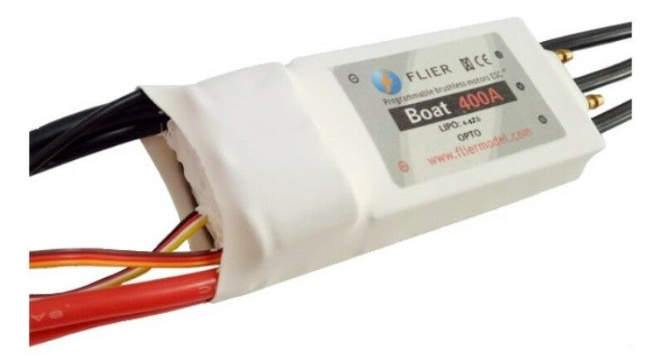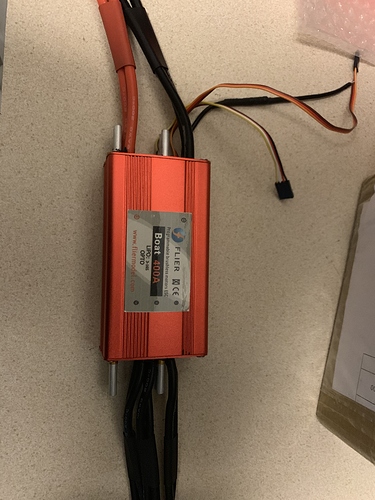yes, mine has both battery leads doubled too… they are just connected to the same place… 2 “small” wired instead of 1 very big…
i picked 400 to be sure not to blow it up and make sure it stays cooled… but as i was never planning to use much more than 100A in the worst case, i only use one wire of each, insulated the other 2…
Gotcha. Do you water cool it?
The goal was not to, but as i was re-building everything, I had the pump, my electronic bay is quite insulated from the outside, and it’s easier to install cooling without using it than route everything afterward, i cooled it.
It’s only running when the ESC goes above 25 degC.
When i tried it in cold weather (around 10 degC) and all i can say is that the pump started after a while, but based on the log i had from the temps sensor attached to the Elogger it reached 35degC after emptying the battery, and i suspect the increase is more due to the batteries getting hot heating the air in the board…
Another option that may be interesting is the ZTW Seal 150A HV or ZTW Seal 300A HV. The 150A is cheap so if it works would be a bargain. This is more for anyone reading the thread that hasn’t bought an ESC.
Almost everyone struggles with an ESC overheating or not handling the current they are running and I don’t fully understand why so many opt to buy an ESC with low Amp rating 120A - 200A when you can buy something like the Flier 400A waterproof and watercooled ESC for only $285 which is like $85 more than a 130A ESC. Trying to save $58-100 on a en ESC is backwards, you should spend the most on it that part because its the brain/heart of the entire efoil. You’ll spend more buying 2-3 esc’s and waste months of time only to look back wish you just bought something heavy duty the first time.
Overkill with your ESC and wiring (6-8 awg) and eliminate 80% of the issue everyone is having so you be out there foiling! 
That’s total nonsense. I have successfully run 120a ESC that cost me £60 from hobbyking. I simply did the heatsink properly. If you know the setup is correctly configured and understand it, there’s is nothing wrong with running a lower amp setup. In fact there’s an equal number of flier 400a that have blown on this forum and on other RC forums.
True, a correct setup can draw 80a max startup and 50a flying at a good speed
Well that’s just it Jezza if you use a proper heat sink/watercooling you can get away with lower max amps and its fine.I cruise at 55A with my jet and wing combo, and I’m 255lbs and can get away with a lower AMP ESC also but the heavier duty ESC just gives the average builder so much more wiggle room for poor cooling. Also smaller AWG wires reduce heat dramatically as well.
Yes I to have also successfully run a 50A skateboard VESC when I first started, never fried it but knew it could not handle that load for long, then I moved onto 130A seaking which worked as well but still its pushing beyond the limits it can handle for very long, then the 400A without ever having a heat issue. Now a custom VESC for 300A built in the UK to allow for programming and additional limits and settings.
I’m not saying you cant use a low AMP I’m saying its just way easier of a build if you spend a little more on a heavier duty ESC and go thicker wiring, so its NOT nonesense. But good for you Jezza that your running a lower amp esc without issues, many builders don’t have the skills and knowledge you do and that is who I am trying to inform because its a major issue for most builders and a relatively simple fix.
Don’t shoot me just because I’m sharing a simple yet effective way to improve a build from day one.
Happy Easter!
HI All! Any recommendations on the source for the Flier 400a ESC? I’ve found them on Aliexpress and some Chinese sites…
I just got the Flier 400. It’s essentially 2 ESC’s in one. Like it’s for a dual motor setup or something. Still trying to figure out if I should hook everything up or run it with half the cables like @Mat did.
On the motor cables I soldered one of the cables to a bullet connector and soldered the second cable on top of the bullet connector and then just heat shrinked over the top of both cables. On the battery end I used eye lugs and connect the positive cables to the 150 amp CB and negative to a 2 post bus bar.
It works well.
you had 6 cables on the motor side??
mine was like below but black…
I didn’t use the smaller anti spark wire as i use XT90 antispark connectors.

You might get better cooling though 
it won’t hurt using all the wires i guess…
I’m not an expert, but I don’t think it’s a dual motor, just 2 smaller wires instead of a big one. Check with a multimeter, i guess you’ll find them connected together.
I emailed Flier and they said it’s OK to use all the wires so maybe I’ll go through the extra trouble of wiring “everything”. Haha!
Anyone seen this thing? T-motor Flame 180 HV. Looks like it just came out. $260 and it says 14S 180A continuous current FOC.
I saw it the other day. It will need airflow as its designed to sit in the prop-flow on multirotors.
Anyone want to buy a Hobbywing Seaking HV130A (v3) for their geared build? It’s fresh from China and still has the shrink wrap - I paid $150 for it. Would like the same, but I ship faster than China and free in NA.
I’ve decided to go jet - mainly because I live in Canada and found out the prop versions are illegal  We have a lot of crazy rules here.
We have a lot of crazy rules here.
Hi Clayton. Bufadore here. We have created a special interest group here in Canada to change the wording of the rules. Since laws are based on definition the open impeller used on jet drives is not actually approved either. We are working with Transport Canada and the legislature to change the regulation. I have been involved in changing drone laws since 2002 and we expect change to happen soon. I would encourage you and others to join our group and continue with enclosed propeller designs. Please feel free to contact me anytime.
Cool. Count me in! Thanks for taking that on.
